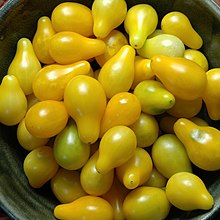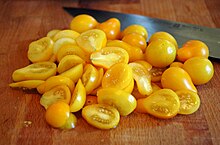


Pear tomato or teardrop tomato is the common name for any one in a group of indeterminate heirloom tomatoes. There are yellow, orange, and red varieties of this tomato, the yellow variety being most common. They are generally sweet, and are in the shape of a pear, but smaller. They are heirlooms and have 3 common other names, such as the "Red/Orange/Yellow Pear Tomato Plants."
History
| This article needs additional citations for verification. Please help improve this article by adding citations to reliable sources. Unsourced material may be challenged and removed. Find sources: "Pear tomato" – news · newspapers · books · scholar · JSTOR (June 2019) (Learn how and when to remove this message) |
The tomato originates from the Americas and was introduced to the Europe in the 16th century. The pear tomato originated in Europe in the 18th century. Within the next century both England and the United States were introduced to the fruit. In 1752 records show the English using it for flavoring soups.
The first recorded yellow pear tomatoes were grown in Europe in 1805. In 1825 the Hudson's Bay Company, Fort Vancouver, once the headquarters of the fur trade in the Northwest, operated a seven-acre farm filled with flowers, herbs, vegetables, and fruits, among which was the yellow pear tomato.
In 1847, three varieties of tomato, including the pear tomato, were grown for the table in the United States. In 1863 seedsman Joseph Ellis offered over a hundred varies of tomato seeds for sale in Utah and Denver, including those of the yellow pear tomato. In 1889, George Thomas & Co. sold pear tomatoes.
In 2001 the Smithsonian Institution in Washington, D.C. completed their heirloom gardens surrounding the National Museum of American History; in this garden, pear tomatoes are featured.
Traits
Classification: Solanum Lycopersicum
Plant Size: Averages 8 feet
Fruit Size: Averages 0.6 oz
Hereditary: Open pollination
Leaf Shape: Compound Leaf
Growing Information
Life Cycle: Perennial
Hardiness Zone: Zone 11 +4.4 °C (40 °F) to +7.2 °C (50 °F)
Space: 2-3 feet apart
Growing Habit: Vine
Light Requirements: Full Sun (6 or more hours of direct sunlight)
Water Preference: Mesic (Constant irrigation)
Fertilization: Plants are Havey feeders and require fertilization prior to transplant, upon planting, 2 weeks before flowering, and 2 weeks after first bloom
Toxicity: Leaves and Roots are toxic to humans and animals
Propagation: Plants can be propagated by seed and cutting. Seeds are self-fertile/self-pollinating and can be taken straight from the plants fruit and directly sown. Plants can also be propagated by stem cutting by cutting the stem below a nondual and replanting
See also
References
- http://www.clemson.edu/extension/hgic/plants/vegetables/gardening/hgic1255.html, Clemson University, Heirloom Vegetables, Tomatoes, Retrieved January 28, 2011.
- http://www.westcoastseeds.com/productdetail/vegetable-seeds/Tomatoes/Yellow-Pear/ Archived 2011-07-18 at the Wayback Machine, West Coast Seeds, Yellow Pear, Retrieved January 28, 2011.
- Dr. Carolyn Male, 100 Heirloom Tomatoes for the American Garden, http://tomatogardener.blogspot.com/2010/07/tomato-profile-yellow-pear.html, Retrieved January 28, 2011.
- https://garden.org/plants/view/109188/Tomato-Solanum-lycopersicum-Yellow-Pear/
- https://www.thespruce.com/guide-to-fertilizing-tomatoes-7151680